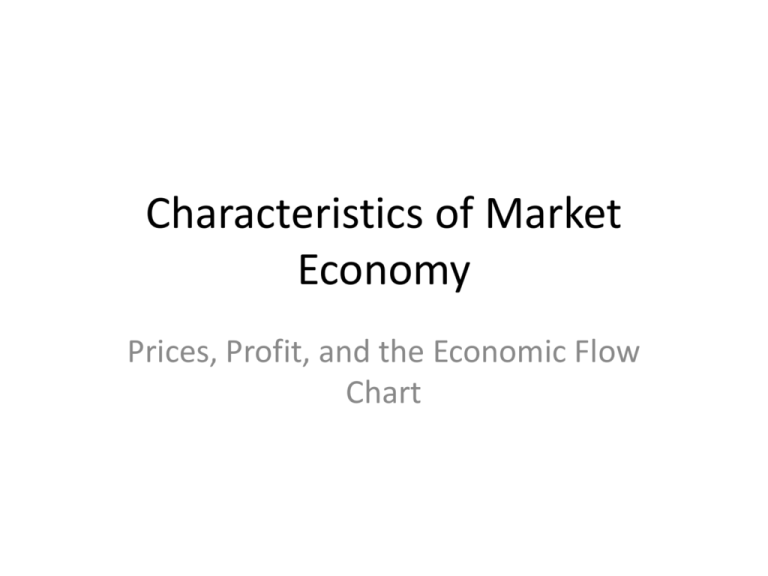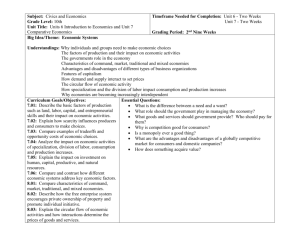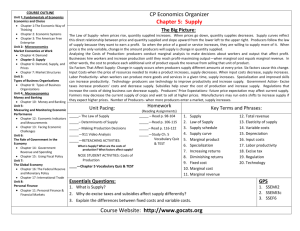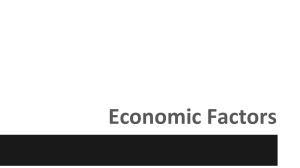Charecteristics of Market Economy
advertisement

Characteristics of Market Economy Prices, Profit, and the Economic Flow Chart Essential Questions • What are the synonyms of a Market Economy? • What are the main features of a Market Economy (private property, limited government regulation, profits, supply and demand, prices, competition (invisible hands))? • How do prices, profits, and competition interact and direct economic activity within a Market Economy? • How do modern governments influence economies? • Why do modern governments influence economies? • How can economies increase production and efficiency (specialization, division of labor, increasing human capital, assembly line, …)? • How does a circular flow model analyze macroeconomic activity? • How do businesses determine prices in order to obtain a profit? Market Economy Synonyms • Free Market • Capitalism • laissez faire Key Characteristics • • • None to Limited Government Regulation Relationship between Supply and demand Profit motive • Business are motivated by the potential to make a profit, this motivation heavily influences decision making Key Characteristics • Private ownership of business • Private property rights – – – – – Copyrights Trademarks Patents Licensing Royalties • Invisible Hands Roles • Three key roles with in a Market Economy – Profit • Acts as an incentive – Competition • Acts as a regulator – Prices • Acts as a coordinator Prices • Smith argued that market economies regulate themselves for maximum productivity through price • Prices set the costs of goods and services • By setting costs, prices balance and regulate a capitalist economic system • Producers can make the most profit & consumers can get the most goods & services Competition • Assumes most productive economy encourages competition • Producers compete against each other for buyers – This drives prices down • This increases efficiency because producers have to charge less, so in order to remain profitable they must increase efficiency • Workers compete against each other for wages • Division of labor increases productivity by dividing work • Example: assembly line, specialization Profit Motive •Acts as an incentive because people would not start or engage in business if monetary gains were not possible. •It is the money that remains after all costs are deducted. •Every business venture includes risk , for if it fails the people involved will loose money. •Therefore, people will only enter a market if the potential reward outweighs the risks. •Investors will not provide capital if the potential for their invest to grow is unlikely. •Entreprenuers would not risk their money or time if the potential for profit was absent. •Therefore, without profit economic advancements will not occur. Consumer Sovereignty • • Recent important development in understanding market economies is called consumer sovereignty Choices of consumers influence the economy more than the choices of producers o Producers only make a profit if consumers buy their products The Role of Government in Capitalism • • • To balance the economy, Smith argued, prices must be set by free choices between producers & consumers – not by the government French made this point with the term laissezfaire: o “let them do” Smith believed that capitalism would meet the needs of society through the so-called “Invisible Hand” o Producers following their own self interest would benefit everyone because producers make the most profit by serving the wants & needs of consumers Pros & Cons Pros: efficient, rewards innovation, opportunities for growth, can become wealth • Cons: income inequality, lack of regulation can harm consumers and/or environment The Role of Modern Governments • As discussed yesterday, most economies are mixed. • In the U.S., the government intervenes it certain cases: – Control the flow of money and interests rates in order to control inflation and encourage or discourage lending (Federal Reserve in US; IMF; World Bank) – Manage recession and depression • Monetary policy • Borrowing • Bailout, subsidies – Ensure competition through breaking up monopolies and other antitrust laws – Allow monopolies deemed necessary • Utilities, cable, ect. – Provide public goods when there is no profit motive for private industries such as • Education, parks, and roads The Role of Modern Governments • Protection of private property – Property rights ensure that producers can profit from their innovations. • • Free from intellectual theft Due Process Rights – – – Search and seizure Fair compensation Privacy rights – Without it people the profit motive would diminish and therefore there would be no incentive. • • • • Copyright laws Patents Plagiarism Subsidies – Government offers payments to industries deemed important in order to protect it form competition, usually foreign competition • Farm aid – Lower costs, so companies can offer goods and services at lower prices without losing profit margin – Lower price increase the competiveness of the business or industry The Ups and Downs of a Market Economy Two competing models for government intervention during recessions and depressions: a. b. A. Keynesianism says that fiscal policy (government spending & taxation) and deficit spending (the spending of borrowed money by the government to combat recession) can balance the economy B. Classical response argues that government spending only prolongs the downturn and it is better to do nothing and let it bottom out, so the market can begin its own natural recovery. Business Organizations • Allow people to combine capital and enterprise to do business for profit • Come in different forms: o o o o Sole proprietorship General partnership Limited-Liability partnership Corporation Business Organizations • Sole Proprietorship • o Single owner o Owner takes all risk and all profit General Partnership o Form through an agreement among the owners o Each partner is fully liable for all business debts o Partners decide together what to do with profits Business Organizations • Limited-liability partnership: o Must file a certificate with the government o Organization that is more formal than general partnership o Nature of the business is still determined by the partners o Limited partners have limited liability for business debts Business Organizations • Corporations o File charter/certificate with the government o Formal organization prescribed by law o Shareholders have a limited liability for the business’s debts and share in the profits through the value of stock or dividends How to improve Productivity • • • •• Innovation Definition: creates new inventions & technologies used in business success Come from the machines to technology Contribute to economic growth Recent inventions or technological innovations with large economic impacts: o o o Computers Virtual reality Wireless networks • Human Capital – Definition: a person’s skills & ability to be economically productive – Some comes from natural talents & abilities – Most comes from education & training – Education & training is especially important in our current economy which depends heavily on innovation How to improve Productivity • Assembly Line • Specialization o Uses division of labor and specialization • the specific task and o Example: automobiles are skills that an individual made on an assembly line contributes to the in a factory • Mass Production division of labor o Made possibly by the • Concentration on single division of labor & specialization tasks increases labor • •Division of labor productivity • • breaks down a job into a series of specific tasks for maximum production Each worker focuses on one or a few tasks Allows workers to practice and perfect a particular set of tasks o Low skilled workers use machinery to produce large numbers of standardized products Types of Business Costs • Fixed costs: business costs that do not depend on the level of production o Example: Rent • Variable costs: depend on a firm’s level of production o Example: Overtime pay • Total costs: combination of fixed & variable costs into the overall cost of operating at a particular rate of production Types of Business Costs • Marginal Costs o • Measure the balance of costs & benefits from the decision to produce an additional unit of good or service Marginal Cost of the Additional Unit o o Cost of the additional factors of production needed to produce the unit Example: Auto Manufacturer wants to make an additional truck Marginal cost refers to: materials, labor, building costs that went in to making it Company stops increasing production when marginal costs lower profits Revenue • Price: the producer must determine the willingness of consumers, or the demand, the total and marginal costs • of the product, and the desired profit in determining the price. Once a projected price is determine the producer can estimate revenue in order to determine the profit. • • • Total Revenue is the amount of money a business takes in from selling a good or service; price*amount sold=total revenue Marginal revenue is the additional revenue from selling one more unit Profit is then determine by subtracting total revenue from total costs






